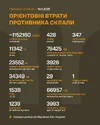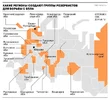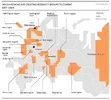November 10, 2025, 1:34 AM
Regions are gathering reserves
A mass recruitment of volunteers to protect critical facilities has begun in the constituent entities of the Russian Federation.
A recruitment campaign has begun in Russian regions to recruit volunteers for units that will be deployed to protect critical facilities. The law, which allows for the use of reservists for such purposes not only in wartime but also in peacetime, was signed by the president on November 4. According to Kommersant's estimates, this work is already underway in two dozen regions of the Russian Federation. Reservists primarily deployed to counter enemy drones will receive military status for this period, with all the associated benefits, including social guarantees and payments.
Photo: Artem Krasnov, Kommersant
As Kommersant previously reported, the formation of specialized reservist units began even before the relevant legislative amendments came into force. Leningrad Oblast authorities were among the first to announce the creation of the BARS-47 unit, designed to repel drone attacks and sabotage (
see Kommersant's October 28 report ). By mid-November, according to open sources, similar campaigns had begun in at least 19 regions of the Russian Federation (see map).
Specifically, recruitment for reservists to guard oil facilities in Kazan and Nizhnekamsk opened in late October in
Tatarstan , and in early November, according to local television channel NTR 24, the first detachment of 21 soldiers departed Nizhnekamsk for military training in Kazan. In
Bashkortostan, reservists will form "mobile fire teams" to protect key fuel, energy, and petrochemical facilities from drones, including Bashneft refineries and industrial sites of Ufaneftekhim and Gazprom. And in
the Nizhny Novgorod Region, the first 15 reservists have passed all selection stages at the Kstovo military enlistment office, signed contracts, and, after training, will be deployed to protect important critical infrastructure facilities in the region.
In the border regions
of Belgorod ,
Bryansk , and
Kursk, BARS units were established back in 2024. They reported to local authorities and performed similar tasks of protecting strategic facilities and infrastructure. Now, under the new law on reservists, additional units are planned to be formed in the Bryansk and Kursk regions, which will operate alongside existing units. In Belgorod Oblast, the current structure will likely remain.
Despite Defense Ministry officials' claims that reservists will only be deployed within their own region, the law contains no such restrictions. However, according to Kommersant, a corresponding provision is included in the standard contract signed by citizens upon enlistment in the BARS.
For example, documents from the Nizhny Novgorod BARS-NN state that the Ministry of Defense "guarantees the execution of missions within the Nizhny Novgorod Region." Moreover, in border regions, reservists will not limit themselves to guarding fuel and energy companies and protecting against UAVs: they are also tasked with disrupting the activities of enemy sabotage and reconnaissance groups, participating in the evacuation of populations if necessary, and supporting counterterrorism operations.
As a reminder, individuals in the mobilization reserve will be recruited to protect important facilities through special training sessions, the procedure for which will be determined by the government. A draft resolution to this effect, developed by the Ministry of Defense, was posted on the draft legal acts portal on November 7. According to this document, age restrictions for reservists depend on military rank: up to 50 years for privates and sergeants, and up to 60–65 years for junior and senior officers. Candidates must have a health fitness category of at least B, a minimum of nine years of education, and no criminal record.
The duration of training must not exceed six months per year, and participants will receive military status for this period, with all the corresponding social benefits. Specifically, reservists are entitled to payments for the duration of their training, while maintaining their average salary at their primary place of employment, as well as additional allowances and bonuses based on their performance. In the event of a reservist's death, their family is entitled to payments and benefits similar to those provided to military personnel.
The amount of pay, as Kommersant has discovered, depends on the region and the nature of the service.
For example, in the Bryansk region, monthly allowances range from 40,500 rubles for privates to 99,300 rubles for detachment commanders, with an additional 4,000 rubles provided for each combat duty. In addition, reservists receive one-time payments from the Ministry of Defense (35,000 rubles each) and the regional budget (150,000 rubles for a six-month contract and 300,000 rubles for an annual contract). In other regions, regular payments are more modest (for example, in the Tula region and Bashkortostan, they range from 2,000 to 10,000 rubles per month, and in Perm Krai, from 4,000 to 7,000 rubles), but the amounts for participating in training are higher: in the same Tula region, reservists with the rank of private receive up to 110,500 rubles for this period, and officers – up to 150,000 rubles.
Dmitry Sotak; Anar Zeynalov, Kazan; Sergey Tolmachev, Voronezh; Andrey Repin, Nizhny Novgorod; Idel Gumerov, Ufa; corset “Kommersant”












 Tunnettuja kiinalaisia valmistajia
Tunnettuja kiinalaisia valmistajia